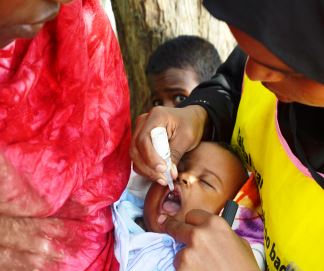 There is no cure for polio and the vaccine is safe and effective. Children should be vaccinated several times to ensure they are protected for life and adults too can carry the virus.Nairobi, 19 February 2015 – Somalia is marking six months since the last polio case was seen in the country following an outbreak that affected 199 people, mostly children.
There is no cure for polio and the vaccine is safe and effective. Children should be vaccinated several times to ensure they are protected for life and adults too can carry the virus.Nairobi, 19 February 2015 – Somalia is marking six months since the last polio case was seen in the country following an outbreak that affected 199 people, mostly children.
Polio was detected in Somalia in May 2013, for the first time in six years, after the parents of a two-year-old girl in Mogadishu found she was unable to walk. The virus, which can cause paralysis or even death, spread quickly affecting 194 people in 2013. However the number was contained to just five cases in 2014, one of them an adult who died, all in the remote Mudug region of Puntland, north-eastern Somalia. The last case was reported in Hobyo district, Mudug on 11 August 2014.
Since the outbreak began, the authorities, with the support of the United Nations Children’s Fund, UNICEF and the World Health Organization (WHO) have targeted more than 2 million children under the age of five for vaccinations as well as children aged from five to 10 and adults in some areas. The vaccination campaigns began as soon as the news of the first case came out as at the time Somalia was home to the largest pool of unvaccinated children in the world with over half a million children unvaccinated for more than five years.
Despite the news, the authorities and the UN are taking a cautious approach since the task of eradication is not finished yet. Polio continues to threaten the lives of Somali children and the campaigns to eradicate polio will continue in 2015.
“It is a breakthrough that the polio outbreak has been curbed. No new cases of polio have been reported over the past six months. The vaccination campaigns have been a massive undertaking from the community level upwards and we must keep up the momentum until we are sure polio has been completely wiped out,” said the Humanitarian Coordinator for Somalia, Philippe Lazzarini.
Somalia reported its last indigenous wild poliovirus (WPV) case in 2002. In 2005, the country experienced an importation of WPV of Nigerian origin, which resulted in an explosive outbreak all over the country and a total of 228 polio cases. With an intensified polio immunization response, Somalia was able to stop the circulation and reached polio free status again in 2007.
“We have defeated polio before and we will do it again,” said UNICEF Somalia Representative Steven Lauwerier. ”This is an important milestone, but there is no room for complacency. We will continue to support the Somali health authorities with the vaccination campaigns until we are certain that no more children will suffer from this highly infectious disease.”
The routine immunization coverage rate in Somalia is extremely low and during the polio vaccination campaigns, the vaccinators have painstakingly gone house to house to administer the vaccine which consists of two drops in the mouth.
“The tremendous effort of Government of Somalia and its partners in containing the outbreak is highly commendable. But polio has not yet been stopped for good, and efforts must continue to ensure polio free status for children in Somalia,” said Dr Ghulam Popal, WHO Somalia Representative. “Care and vigilance are crucial to ensure that children all over Somalia are vaccinated, despite the challenges posed by inaccessibility and insecurity. In addition, strengthening surveillance systems so that polio cannot continue to be transmitted undetected, is a crucial component of moving towards polio free Somalia.”
Sanitation is poor in many areas of Somalia. The polio virus is quickly transmitted through water or food contaminated with human waste from an infected person. Proper sanitation is one way to prevent it spreading.
There is no cure for polio and the vaccine is safe and effective. Children should be vaccinated several times to ensure they are protected for life and adults too can carry the virus.
For more information please contact:
UNICEF: Susannah Price
+254 722 719867


